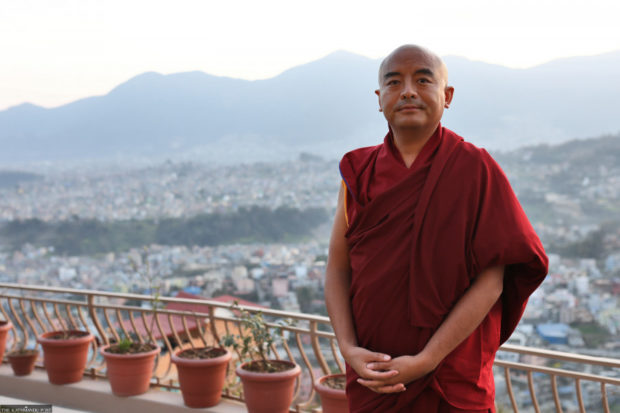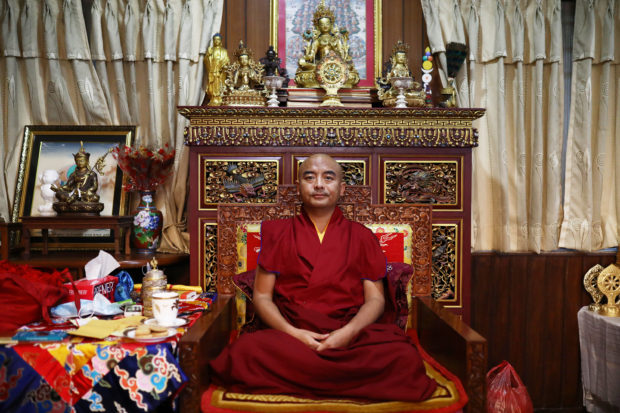
KATHMANDU — Born in the remote village of Samagaun in Gorkha, Yongey Mingyur Rinpoche is one of the most globally renowned meditation teachers of his generation. His first book, ‘The Joy of Living’, was listed on The New York Times’ best-seller list and has been translated into over 20 languages. He has since gone on to author six more books. Recently, Mingyur Rinpoche launched ‘Jiunuko Majja’, a Nepali translation of his widely acclaimed book ‘The Joy of Living’.
Rinpoche first started practising meditation when he was nine, and at the age of 13, he went to India to study Tibetan Buddhism. He now heads the Kathmandu-based Tergar Osel Ling Monastery and has spent the last 30 years teaching Buddhism and meditation in not just Nepal but all over the world.
In this interview with the Post’s Tsering Ngodup Lama, Mingyur Rinpoche talked about the growing interest in meditation among Nepalis and how this made him launch ‘Jiunuko Majja’, the importance of practising meditation in today’s world, and why he has been so vocal about the impact of climate change and food insecurity in his home village. Excerpts.
‘Jiunuko Majja’ is the latest Nepali translation of your The New York Times Bestselling book ‘The Joy of Living’, which was first published in 2007. Why did you feel the need to publish yet another Nepali translation of ‘The Joy of Living’?
I was seven or eight years old when I started experiencing panic attacks. I was too young to understand what panic attacks were. When I started practising meditation at the age of nine, I found myself better equipped to understand and deal with my panic attacks. ‘The Joy of Living’ is about how meditation has benefitted me throughout my life and the many discussions I have had over the years on the interconnectedness between Buddhism and modern science.
A few years ago, someone translated ‘The Joy of Living’ into Nepali, but many told me that the jargon in the book made it very difficult for them to read it. In the last few years, I have seen a growing interest among both Buddhists and non-Buddhists to learn Buddhism and meditation, and this is why we decided to translate the book into Nepali once again and came up with ‘Jiunuko Maja’.
The mental health crisis caused by the Covid-19 pandemic has renewed interest in meditation and mindfulness. What do you think about this development?
This is a positive development and something the current world desperately needs. So many people have lost their loved ones to the pandemic, which has also caused so much economic uncertainty. In these uncertain times, being more aware of one’s emotions and thoughts helps a lot. For over 2,000 years, many people have relied on the meditation techniques taught by Buddha to train themselves to become more aware of their thoughts and emotions. Even though the techniques might have been developed centuries ago, they are still relevant today, and in the 30 years that I have taught meditation, I have seen people who practise meditation diligently transform themselves. What is essential for people to understand is that qualities like awareness, love, and compassion are innate in us. But our minds are so used to being cluttered with self-centric and egoistic thoughts that these noble qualities get obscured. Meditation allows us to become more in touch with these qualities.

Communities in remote mountains of the country have been disproportionately affected by climate change, and it is a topic you have been very vocal about. What kind of climate change impact are you seeing in your village of Samagaun?
When I was a boy, we could reach glaciers by walking just two hours from our village. But we now have to walk eight hours from our village to reach the nearest glacier. Places that once used to be covered with snow year-round are just barren rocks. Another concern is the unpredictable weather, which has become a norm in our village. We now get snowfall in the spring, something underheard of when I was growing up. We are seeing long dry spells during months when we should be getting rainfall. This year we received unprecedented heavy rain, and this destroyed many crops. Due to the heavy downpour, people couldn’t also harvest yarsagumba [ophiocordyceps sinensis], which is one of the primary sources of cash income for our people, in the quantity they once did.
The erratic weather pattern has also made it difficult for farmers in our village. Natural disasters are also becoming more common. This year we saw the first flooding in our village in 30 years.
Another issue that we have witnessed in our village is deforestation. Since 2008, 35 percent of native forests around Samagaun have been deforested. To re-green the barren land, we have been helping a local project that has already planted 30,000 pine trees. Our organisation, Tergar Charity Nepal, has planted 1,000 goji berry plants on deforested lands. Goji berries are highly nutritious fruit and are also native to the region. This plantation project will help re-green barren land and provide villagers with an additional source of income. If things go well, we will be planting 50,000 to 100,000 goji berry plants.
Very little grows in many of Nepal’s remote mountainous villages, making many communities in the region food insecure. Tell us how critical of an issue food insecurity is in your village?
Our village’s topography and climatic conditions are not ideal for farming. This is why most of what our villagers eat daily are sourced from the nearest town, which is almost six to seven days’ walk away. A vegetable costing Rs 100 kg in the town costs Rs 700 to Rs 800 by the time they get to our village.
In 2020, when Nepal went into lockdown, it disrupted our village’s food supply chain and people suddenly no longer had access to many food items. This made us realise the importance of food security and lessening our dependence on external food supply. That very year, Tergar Charity Nepal selected the 15 most economically vulnerable families in our village and built greenhouses for them to grow vegetables and herbs. This project has been an enormous success. These families are now growing cabbage, cauliflower, spinach, carrot, tomato, cucumber, watermelon for ten months of the year. Without greenhouses, people could only grow radish and potato, and that too for only five months a year. Villagers are now also selling vegetables, fruits, and herbs to restaurants and guesthouses in the area and making extra income.
We plan to set up 30 more greenhouses for families in the village. Families from neighbouring villages have also approached us to help them build greenhouses, and we will be doing that as well.
Coming back to meditation and mindfulness, what do you think about the importance that’s been given to the two in Nepal?
Compared to the past, more Nepalis have become interested in meditation, and it is this very growing interest that made me launch ‘Jiunuko Majja’. But we have to understand that as human beings, most of us tend to focus on self-exploration only when our other needs are met. The majority of Nepalis within the country are focused on fulfilling their basic needs, which is necessary and understandable. But unlike other countries, Nepal is the birthplace of Buddha and home to this ancient knowledge of meditation, and I think that if our people can adopt it in their daily lives, it will be immensely beneficial for all.
See, if you want to become a doctor, you have to go to a medical school and learn anatomy, physiology, and a host of other things. But if you want to free yourself from your mental afflictions, you have to study your mind and its workings. Doing so will allow us to discover the innate goodness that exists within all of us, and the best method that I know of that will help us discover our true potential is meditation.
RELATED STORIES
Mental health in a time of pandemic: The invisible suffering
Try meditation during quarantine
Give yourself a moment of mindfulness with these meditation apps
Best meditation apps for better relaxation









































